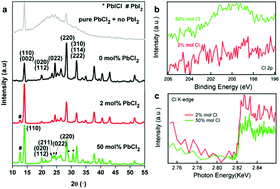Incorporation of Cl into sequentially deposited lead halide perovskite films for highly efficient mesoporous solar cells†
Abstract
Organic–inorganic lead halide perovskites have been widely used as absorbers on mesoporous TiO2 films as well as thin films in planar heterojunction solar cells, yielding very high photovoltaic conversion efficiencies. Both the addition of chloride and sequential deposition methods were successfully employed to enhance the photovoltaic performance. Here, both approaches are combined in a sequential method by spincoating PbCl2 + PbI2 on a mesoporous TiO2 film followed by the perovskite transformation. The role of Cl in determining the optical, electrical, structural and morphological properties is correlated with the photovoltaic performance. The highest photovoltaic efficiency of 14.15% with the Voc, FF and Jsc being 1.09 V, 0.65 and 19.91 mA cm−2 respectively was achieved with 10 mol% of PbCl2 addition due to an increase of the film conductivity induced by a better perovskite morphology. This is linked to an improvement of the hysteresis and reproducibility of the solar cells.


 Please wait while we load your content...
Please wait while we load your content...